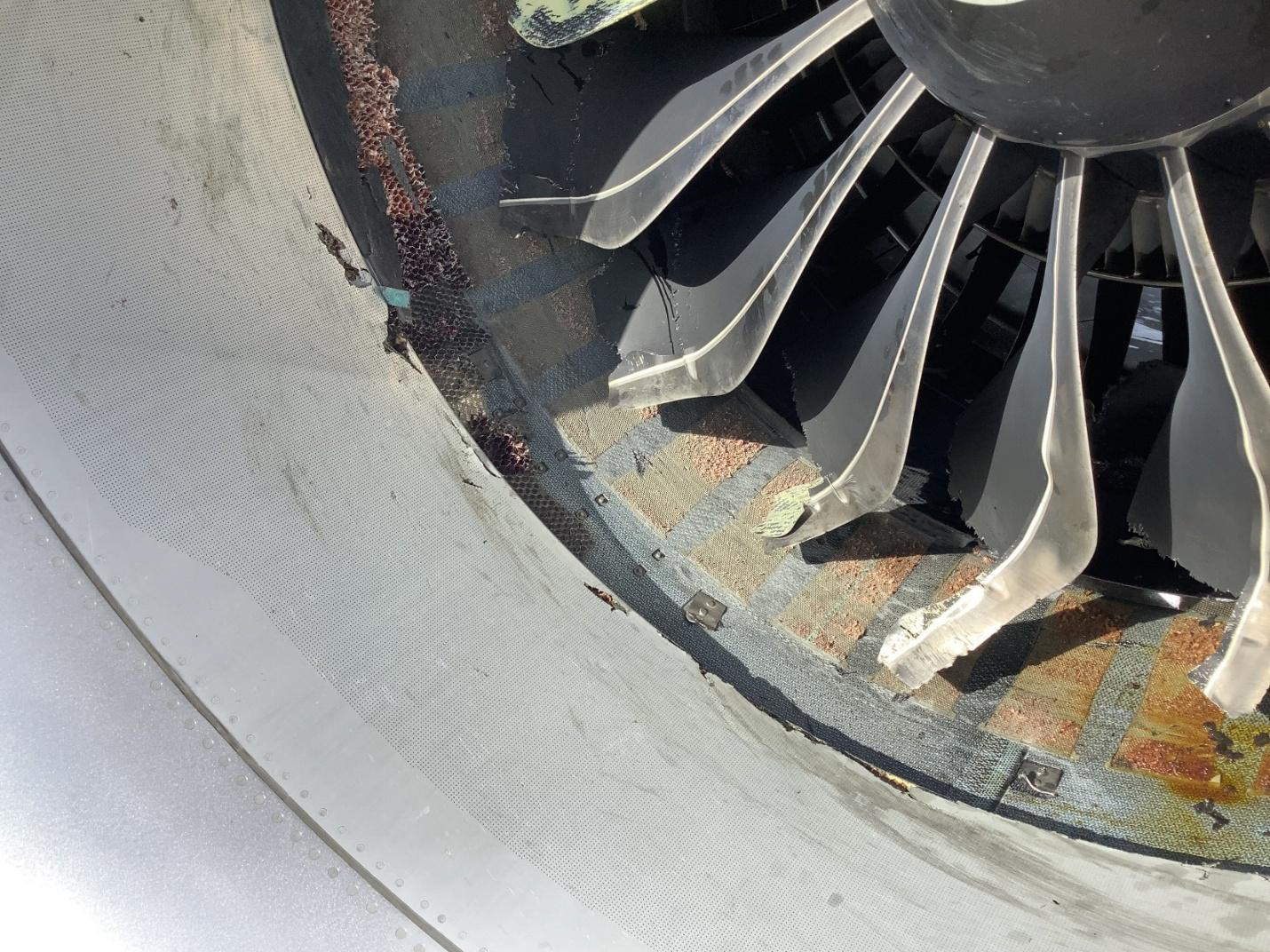Boeing Keeps Not Telling Pilots About Jet Design Features
How a well designed safety feature can potentially doom a jetliner

Damage on engine No. 1 of Southwest flight 554 after a blade out event caused by a birdstrike (photo: Southwest Airlines)
If you are afraid of flying, you probably don't want to read the following article.
The CFM International LEAP engines on some Airbus 320neo and Boeing 737 MAX planes include a clever little device called an LRD (Load Reduction Device). This is essentially a pair of bolts that are designed to sheer off once an engine exhibits significant vibrations. This is pretty cool, because such vibrations tend to make the engine tear itself apart, which could make pieces of it pierce other parts of the airplane, start fires and, when it gets really bad, even damage the pylon that anchors the engine to the wing. This could damage the aerodynamics of the wing and cause the plane to crash.1
Since the LEAP engine has fewer fan blades than other comparable engines and these are also bigger, this is especially dangerous on those engines. So to prevent an engine from tearing itself apart like this, CFM came up with a cool little solution: Have bolts that separate under such non-normal rotation stresses and decouple the engine fan from the rest of the engine core. It will then rotate more or less freely, wobbling around off-centre, as the engine spins down, preventing a broken fan or two from completely reducing the engine to smithereens. The plane will then be able to descent to a safe altitude and land with its fuselage otherwise intact and under power of the remaining engine.
That’s a cool idea. But Boeing, Airbus and CFM missed a crucial problem. Decoupling the fan in this way causes about 14 litres of lubricating engine oil to drain from the main oil sump into the compressor stages of the engine core. It will then be heated up extremely quickly in the combustion chamber, is aerosolised and floods the whole engine with white oily smoke. The engine manufacturer as well as Boeing and Airbus knew this. What they didn’t consider is that this smoke would flood the cockpit of the plane. This is bad. Not only because smoke makes it hard to see the instruments, but it is also extremely toxic smoke that could kill the pilots in under a minute if they breath it in for that long.
Why does this smoke end up in the cockpit? This is because on the 737, and to a lesser extend on the A320, the left (No. 1) engine provides air for the cockpit while the right (No. 2) engine provides air for the passenger cabin.2 While toxic smoke in the passenger cabin is not good, it is preferrable to having the plane outright crash and burn. Toxic smoke in the cockpit could, however, very well mean that the plane will actually crash and burn. Which is the problem CFM happened to overlook.
This issue only became apparent when two Southwest Airlines 737 MAXs had major smoke in cabin/cockpit incidents a few months apart in 2023 (Southwest Airlines flights 3923 and 554). When the FAA investigated this, they found that Boeing actually hadn’t told pilots that the LRD even existed. Which recalls the kind of stupidity surrounding the MCAS design feature that caused two 737 MAX planes to crash, killing 346 people — something I reported on back in 2019.
Because the US and European regulators (FAA and EASA, respectively) took no action on this design flaw, even after it became known, the NTSB (the US’s National Transportation Safety Board, charged with investigating plane crashes and accidents under US jurisdiction) also investigated the second Southwest Airlines incident, which is the more severe of the two, because the left engine was the one affected, which caused the cockpit to be flooded with smoke so thick the two pilots could barely see each other. The NTSB released its report in June, stating:
It is critical to ensure that pilots who fly airplanes equipped with CFM International LEAP-1B engines are fully aware of the potential for smoke in the cockpit if the load reduction device is activated during a critical phase of flight (takeoff or landing)
Addressing the FAA, the NTSB said:
Ensure operators inform flight crews of airplanes equipped with CFM International LEAP-1B engines of the circumstances described in National Transportation Safety Board Aviation Investigation Report AIR-25-03, emphasizing Boeing’s changes to the quick reference handbook and flight crew operations manual so pilots are aware of actions to take if they encounter smoke in the cockpit or cabin after load reduction device activation. (A-25-10) Urgent
A software fix is in the works that will shut off the bleed air valves, which let air from the engine enter the ventilation system of the plane, immediately after the engine detects that it has been compromised. In the meantime, however, it has become clear that this issue does not only affect the LEAP-1B engines and the ventilation system on the 737 MAX, but also the LEAP-1A engine and ventilation system of the Airbus A320neo.
Now, it is important to point out that these issues are pretty rare. Something like a fan blade out event that would cause the LRD to activate only happens when a very large bird (something like a vulture, eagle or large stork) gets ingested into the engine. While bird strikes are a common occurrence in aviation — around 50 a day on average — most of those don’t hit the engines. And if they do, these engines are designed to just chew up the bird and keep on going. I haven’t experienced this myself, but I hear that the aforementioned bleed air system then often causes the cabin air to smell somewhat like a chicken is being roasted in the cabin. Because engines are designed with bird strikes in mind, fan blades will only snap off if an unusually large bird makes it into the engine. Which is what happened on the two Southwest Airlines flights and it is exactly what the LRD was designed for. Again, a good idea, I just wish they’d considered the rest of the design of the airplane as well.
Luckily, these circumstances are rare and even then, pilots will manage to cope with the smoke problem in most flight situations, as we’ve seen on two 737s and one A320 now. But still, this whole situation is very scary and I hope they deploy that software fix for the 737 MAX quickly — and devise a solution for the A320neo while they’re at it — before someone loses their life. In the meantime, I really also hope that airlines will starting to make takeoffs with the cockpit bleed air system switched off, as explained in that video the previous link points to.
If you want to learn more about this issue, Petter Hörnfeldt from Mentour Pilot has a great video explaining it. But be warned, he explains the scary implications in great detail and doesn’t pull his punches. This video is probably also the reason that the FAA has started to act on this issue, by the way, as it made quite a splash in aviation circles.
-
For a worst-case example of this refer to American Airlines Flight 191. Here is a good video explanation of it: Mentour Pilot — The WORST Single Aircraft Accident in American History ↩︎
-
Unless you’re not a pilot or for other reasons obsessed with aviation, like I am, you probably don’t know why this is, so let me explain. All modern passenger jets (except the Boing 787 for reasons of fuel economy) take the air to pressurise their cabin and cockpit (and do a ton of other stuff) from the compressor stages of their engines. They do this because the cabin and cockpit needs to be pressurised and, funnily enough, that’s exactly what a compressor does to air. So they basically get the means to pressurise the air for free, without expending more energy. The air is normaly clean, because it is taking from early compressor stages in front of the combustion chamber — these compressor stages are labelled ㉜ in this diagram, the combustion chamber is labelled ㊷. The LRD is part of the main bearing support, labelled ㉒, surrounded by the oil sump (in the blue area outside the main rotor shaft). ↩︎

